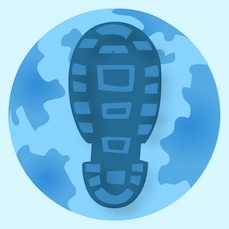Lesson Plans
Lesson plans are divided into three grade and age ranges, with five themes. Some lesson plans have one or more learning perks including the use of our free Species Cards. Lesson plans are created by EOL and partners.
Themes
Classification
Science Skills
Human Impact
Adaptations
Energy Flow
Learning Perks
Biological statistics
Field work
Species cards
Lesson Plans
-

Classification Activity 1: What is Classification?
Students explore the importance and process of classification. Students apply the concept of biological classification to a real hierarchy of birds, analyzing bird photos and organizing them into groups based on physical characteristics. Download Educator Guide for this unit.- Students will classify organisms into groups based on adaptations and traits
- Students will compare, contrast, and discuss the traits of different organisms
-

Classification Activity 2: Animal Classification
Students use EOL Species Cards to sort and make observations of animals, then use the RAFT writing strategy to create short presentations about the characteristics of each major group of animals. Download Educator Guide for this unit.- Students will classify animals into groups based on physical traits and characteristics
- Students will compare, contrast, and discuss the traits of different organisms
-

Classification Activity 3: Plant Classification
After learning about and observing the differences between flowering and nonflowering plants, students go outside and search for plants in schoolyard, keeping notes and drawings of their observations. Download Educator Guide for this unit.- Students will classify flowering and nonflowering plants into groups based on adaptations and traits
- Students will compare, contrast, and discuss the traits of different plants
-

Classification Activity 4: That's Classified!
Students apply their understanding of physical characteristics and biological classification of different organisms through a game of classification "Go Fish!" Download Educator Guide for this unit.- Students will classify organisms into groups based on adaptations and traits
- Students will compare, contrast, and discuss the traits of different organisms
-

Energy Flow Activity 1: Predators and Prey
After making observations and inferences about predator-prey relationships in their schoolyard, students work together to build food chains of the organisms they observe. Download Educator Guide for this unit.- Students will understand predator-prey interactions
- Students will investigate predator-prey interactions in their schoolyard
- Students will visualize how energy flows through an ecosystem via food chains
-

Energy Flow Activity 2: Producers, Consumers, Decomposers
Students become “experts” and make creative presentations about the different ecological roles of producers, consumers, and decomposers at local and global scales. Download Educator Guide for this unit.- Students will investigate how different organisms obtain energy
- Students will identify producers, consumers, and decomposers
-

Energy Flow Activity 3: Building Food Chains
After learning about food chains, students practice building food chains and design their own backyard food chains. Download Educator Guide for this unit.- Students will model the interrelationships of ecosystems
- Students will manipulate ecological relationships through food chains and using EOL Food Webs
-

Energy Flow Activity 4: Food Chains Rummy
Students synthesize their understanding of energy flow and trophic relationships through “Food Chains Rummy,” a modified version of the classic card game using Species Cards. Download Educator Guide for this unit.- Students will build food chains that represent energy flow
- Students will discuss the interconnectedness of organisms
- Students will explore the roles of organisms in ecosystems
-

Adaptations Activity 1: Adapting to the Environment
After learning about and exploring plant and animal adaptations, students research local organisms with interesting adaptations and share findings with their classmates. Students identify adaptations globally by analyzing a documentary. Download Educator Guide for this unit.- Students will understand that adaptations allow organisms to thrive in a particular environment
- Students will differentiate between physical and behavioral adaptations in animals
- Students will explore growth and reproduction adaptations of plants
- Students will identify key adaptations of organisms in different habitats
-

Adaptations Activity 2: Physical Adaptations
Students explore the adaptations that allow beavers to thrive in aquatic environments, then make observations and inferences about the functions of diverse bird beaks. Download Educator Guide for this unit.- Students will understand that physical adaptations are structural or physiological characteristics that allow animals to thrive in their environments
- Students will observe bird beaks and infer their functions
-

Adaptations Activity 3: Behavioral Adaptations
Students discuss the migration of monarch butterflies as an example of behavioral adaptations, then act out the behavioral adaptations of organisms in charades. Download Educator Guide for this unit.- Students will understand that behavioral adaptations are actions/behaviors that allow animals thrive in their environments
- Students will visualize the purpose and challenges of migration
-

Adaptations Activity 4: Go Adapt!
Students synthesize their understanding of adaptations by playing a “go fish” style game to collect sets of organisms with physical and behavioral adaptations. Download Educator Guide for this unit.- Students will identify behavioral and physical adaptations for plants, animals, fungi, and other organisms
- Students will classify organisms into groups based on adaptations and traits
- Students will compare, contrast, and discuss the adaptation traits of different organisms
- Students will interpret and explain their sets of adaptations, classification, and energy flow
-

Adaptations Activity 5: Create a Creature
Students apply their understanding of adaptations by designing their own organisms to survive in different habitats. Download Educator Guide for this unit.- Students will design and share their own organisms with adaptations
- Students will synthesize their understanding of physical and behavioral adaptations
-

Skillbuilder 1: Meet a Creature
Students practice making observations, describing physical characteristics of organisms, and interpreting information. In pairs, students sit back to back; one student describes a creature and the other draws based on the partner’s description. Download Educator Guide for this unit.- Students will interpret and draw an organism based on another student’s description
-

Skillbuilder 2: ID That Bird!
Students observe cutouts of birds around the classroom, sketch and describe field markings, and use field guides to make identifications. Download Educator Guide for this unit.- Students will understand how binoculars function
- Students will practice observation skills through identifying field markings
- Students will identify birds using field guide
-

Skillbuilder 3: How Diverse is Biodiversity
Students explore biodiversity statistics by hypothesizing the number of animal species and comparing to scientific estimates. Download Educator Guide for this unit.- Students will hypothesize the number of animal species and compare to scientific estimates
- Students will explore the various groups of animals
-

Skillbuilder 4: Modeling Classification
Students classify themselves into different groups based on observable characteristics of clothing and accessories, then apply to biological classification systems. Download Educator Guide for this unit.- Students will classify themselves into different groups based on observable characteristics of clothing and/or accessories
- Students will practice observation skills by looking for similarities and differences of each group
- Students will apply their understanding of classification to organisms
-

Skillbuilder 5: ID Using a Dichotomous Key
Students make observations of animals and use a dichotomous key, a common field identification tool, to classify and identify animals based on physical characteristics. Students then design their own dichotomous keys for various objects. Download Educator Guide for this unit.- Students will apply prior knowledge of observation and classification as they practice using a dichotomous key to identify trees
-

Analyzing Bioblitz Data
Students investigate and analyze local biodiversity using iNaturalist observations. They collaborate in small groups to explore observations and identification of various taxon groups. Then students create a class graph of data and draw inferences about biodiversity, invasive species, and endangered species in their local park. This National Geographic Education activity was developed for the 2016 National Parks Service Centennial bioblitzes, but can be adapted for any iNaturalist project or region.- Students will analyze local biodiversity data using iNaturalist bioblitz observations
- Students will use descriptive statistics to visualize and synthesize findings
- Students will make inferences about local biodiversity
-

Skillbuilder 1: Meet a Creature
Students practice making observations, describing physical characteristics of organisms, and interpreting information. In pairs, students sit back to back; one student describes a creature and the other draws based on the partner’s description. Download Educator Guide for this unit.- Students will interpret and draw an organism based on another student’s description
-

Skillbuilder 2: ID That Bird!
Students observe cutouts of birds around the classroom, sketch and describe field markings, and use field guides to make identifications. Download Educator Guide for this unit.- Students will understand how binoculars function
- Students will practice observation skills through identifying field markings
- Students will identify birds using field guide
-

Skillbuilder 3: How Diverse is Biodiversity
Students explore biodiversity statistics by hypothesizing the number of animal species and comparing to scientific estimates. Download Educator Guide for this unit.- Students will hypothesize the number of animal species and compare to scientific estimates
- Students will explore the various groups of animals
-

Skillbuilder 4: Modeling Classification
Students classify themselves into different groups based on observable characteristics of clothing and accessories, then apply to biological classification systems. Download Educator Guide for this unit.- Students will classify themselves into different groups based on observable characteristics of clothing and/or accessories
- Students will practice observation skills by looking for similarities and differences of each group
- Students will apply their understanding of classification to organisms
-

Skillbuilder 5: ID Using a Dichotomous Key
Students make observations of animals and use a dichotomous key, a common field identification tool, to classify and identify animals based on physical characteristics. Students then design their own dichotomous keys for various objects. Download Educator Guide for this unit.- Students will apply prior knowledge of observation and classification as they practice using a dichotomous key to identify trees
-

Analyzing Bioblitz Data
Students investigate and analyze local biodiversity using iNaturalist observations. They collaborate in small groups to explore observations and identification of various taxon groups. Then students create a class graph of data and draw inferences about biodiversity, invasive species, and endangered species in their local park. This National Geographic Education activity was developed for the 2016 National Parks Service Centennial bioblitzes, but can be adapted for any iNaturalist project or region.- Students will analyze local biodiversity data using iNaturalist bioblitz observations
- Students will use descriptive statistics to visualize and synthesize findings
- Students will make inferences about local biodiversity
-

Food Webs Activity 1: Producers, Consumers, Decomposers
Students become “experts” and make creative presentations about the different ecological roles of producers, consumers, and decomposers at local and global scales. Download Educator Guide for this unit.- Students will investigate how different organisms obtain energy
- Students will identify producers, consumers, and decomposers
-

Food Webs Activity 2: Food Web Systems
Students model how a complex system operates and how some parts of a complex system have more leverage or influence on the rest of the system. Students relate this to the interconnectedness of food webs. Download Educator Guide for this unit.- Students will model the interrelationships of ecosystems
-

Food Webs Activity 3: Food Chains and Webs
Students practice building food chains and webs, explore interrelationships in the EOL Food Webs Tool, then model the flow of energy in food webs. Download Educator Guide for this unit.- Students will describe how energy flows through food chains and food webs
- Students will model the interrelationships of ecosystems
- Students will manipulate ecological relationships through food chains and using EOL Food Webs
-

Food Webs Activity 4: Food Chains Rummy
Students synthesize their understanding of energy flow and trophic relationships through “Food Chains Rummy,” a modified version of the classic card game using Species Cards. Download Educator Guide for this unit.- Students will build food chains that represent energy flow
- Students will discuss the interconnectedness of organisms
- Students will synthesize their understanding of the roles of organisms in ecosystems
-

Animal Behavior: Whale Communication
Students will listen to a podcast that discusses an experiment designed to learn how male and female right whales find each other during mating season. The podcast is accompanied by discussion questions and a graphic organizer. This activity was designed by Listenwise.- Students will discuss research methods for studying whales
- Students will understand how and why scientists study whale communication
-

Animal Behavior: Hibernation
In this simulation activity, students search for hibernation sites that will protect gelatin "animals" from freezing. This activity was designed by Outdoor Biology Instructional Strategies at the Lawrence Hall of Science and accompanied by an EOL Collection and memory game.- Students will conduct an experiment to learn what areas of a “habitat” are the best for protecting a hibernating species from the cold
-

Animal Behavior: Camouflage
Students invent an imaginary animal that blends into its habitat. This activity was designed by Outdoor Biology Instructional Strategies at the Lawrence Hall of Science and accompanied by an EOL Collection and memory game.- Students will understand that an animal's coloring, markings, shape or behavior can help it camouflage or hide itself from predators or prey
-

Human Impacts: Coral Bleaching
Students listen to a podcast that examines the effect of climate change on coral reef ecosystems. This activity was designed by Listenwise.- Students will understand the physical structure of corals
- Students will discuss the effects the major threats coral reefs face
-

Human Impacts: Crayfish and Commerce
Students listen to a podcast that examines how both biology and business helped crawfish circumnavigate the globe. This activity was designed by National Geographic.- Students will examine how business can affect biodiversity
-

Human Impacts: Dolphins and Bycatch
Students listen to a podcast that examines how dolphin populations are impacted by tuna fishing. This activity was designed by Listenwise.- Students will discuss how technological advances in tuna fishing have impacted dolphins
- Students will understand how studying dolphin tissue samples from impacted dolphins can help scientists protect dolphin populations
-

Human Impacts: Ocean Acidification
Students listen to a podcast that discusses how marine food webs are affected by ocean acidification. This activity was designed by National Geographic.- Students will understand the role that tiny Sea Butterflies (Pteropods) play in a marine food web
- Students will observe the effect that ocean acidification has on the fragile shells of Pteropods
-

Investigating Biodiversity: iNaturalist Data Analysis
Students explore iNaturalist data and use data to design and carry out investigations in small groups about biodiversity at local, regional, and global scales. After synthesizing information, students present findings to the class.- Students will explore local observations using iNaturalist
- Students will investigate and analyze data using iNaturalist data filtering and export features
- Students will draw inferences about the patterns among organisms at different scales
-

Interdependence Activity 1: Food Chains and Webs
Students practice building food chains and webs, explore interrelationships in the EOL Food Webs Tool, then model the flow of energy in food webs. Download Educator Guide for this unit.- Students will describe how energy flows through food chains and food webs
- Students will build and examine food chains and food webs
- Students will manipulate ecological relationships through food chains and using EOL Food Webs
-

Interdependence Activity 2: Food Web Systems
Students model how a complex system operates and how some parts of a complex system have more leverage or influence on the rest of the system. Students relate this to the interconnectedness of food webs. Download Educator Guide for this unit.- Students will model the interrelationships of ecosystems
-

Interdependence Activity 3: Food Chains Rummy
Students synthesize their understanding of energy flow and trophic relationships through “Food Chains Rummy,” a modified version of the classic card game using Species Cards. Download Educator Guide for this unit.- Students will build food chains and webs that represent energy flow
- Students will discuss the interconnectedness of organisms
- Students will synthesize their understanding of the roles of organisms in ecosystems
-

Biodiversity + Open Science Activity 1: Introduction to Biodiversity
Students explore local and global biodiversity by the numbers. They compare and contrast biodiversity graphs representing scientifically described species vs. those observed on iNaturalist.org, an online observation platform. Download Educator Guide for this unit.- Students will compare and contrast biodiversity at different scales
- Students will hypothesize the global numbers of species of plants, animals, fungi, and other organisms
-

Biodiversity + Open Science Activity 2: Guided Citizen Science Presentation
Students explore the broad spectrum citizen science projects and learn how individuals can contribute to global biodiversity knowledge. Download Educator Guide for this unit.- Students will address misconceptions about science and who can “do” science
- Students will explore how the public can participate in the scientific process through citizen science and open science pathways
- Students will discuss the benefits and challenges of citizen science
-

Biodiversity + Open Science Activity 3: Introduction to iNaturalist
Students learn how to use the iNaturalist.org platform to search, filter, and organize observation data. They practice making observations and contributing to this online community. Download Educator Guide for this unit.- Students will contribute to the ongoing effort to discover and document biodiversity
- Students will practice how to filter, search, and organize observations in iNaturalist
-

Biodiversity + Open Science Activity 4: City Nature Challenge Data Exploration
Using data from the 2017 iNaturalist City Nature Challenge (CNC) students research and compare information about participating cities and their city and share information and outcomes. Download Educator Guide for this unit.- Students will compare and contrast observations in different cities from the CNC
- Students will investigate and draw inferences about invasive, endangered, and unique species in their communities
Image Credits
EOL promotes content sharing via Creative Commons and other open licenses. Learn more about EOL's Licensing Policy.
Grass by Moyan Brenn via Flickr CC-BY


